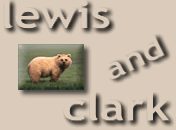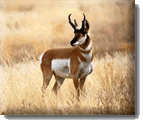| The Desert Cottontail is named after the area they like to live in - the arid lands of the American Southwest and Plains states, and their cottony white tail. They are light-colored tan to gray with a yellowish tinge. The Desert Cottontail normally weighs about 2 to 3 pounds and has large hind feet. It can run up to 20 miles per hour to escape predators. |
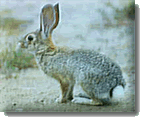 |
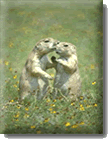 |
The Black-tailed Prairie Dog is the most abundant and widely distributed of the four species of prairie dogs found in North America. They are yellowish tan in color and have a black-tipped tail. Prairie dogs live as groups in "towns" which can cover 1 to over 1,000 acres. They are diurnal animals, and spend much of their day visiting and grooming each other as well as feeding. |
| Bobcats were first spotted by the Lewis and Clark expedition on April 7, 1805. They are light gray to brownish in color with dark spots. Bobcats weigh from 14-29 lbs., have ears that are slightly tufted, and tails that are short and stubby ("bobbed"). Bobcats make their homes in scrubby country or forests, and sometimes swamps and farmland. They are found only in North America. |
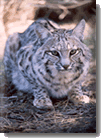 |
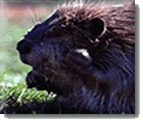 |
The Missouri Beaver was first noted by Lewis and Clark on July 3, 1804, in Platte County, Missouri. The beaver is a very large rodent with dark brown fur and a large, black, paddle-shaped tail. Using its webbed hind feet, it can swim at speeds of up to 6 mph. Beavers make their homes in rivers, streams, marshes, lakes, and ponds. |
| Coyotes are a member of the dog family which includes wolves, dogs and foxes. The color of their coat ranges from almost pure gray to a red-brown. They have broad, pointed, erect ears and yellow eyes. Coyotes can be found throughout the United States living in a variety of habitats including grasslands, forests, and even very close to human populations. |
|
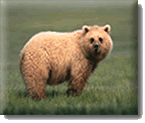 |
The Grizzly Bear has a coat of blond, brown or black hair that is tipped in white or silver, hence its nickname "the White Bear." Even though the grizzly weighs between 300-1500 pounds, it can run up to 35 mph! (No wonder the Indians warned Lewis and Clark about this mammal!) Grizzly bears are primarily nocturnal animals and feed on plants, berries, roots, fish, insects, and small mammals. |
| This weasel has a long body, short legs, and a tail that is often as long as its body! Their body is brown on top and white to yellow underneath. Long-tailed Weasels are found in forested, brushy, and open areas, preferably near water. It makes its home in abandoned burrows of other mammals such as chipmunks or moles. Weasels are valuable in controlling populations of rodents such as rats. |
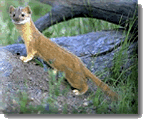 |
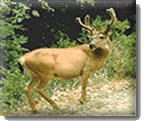 |
Mule Deer get their name from their large ears that move constantly and independently of each other. They are reddish-brown in color and weigh from 125-330 lbs. Mule deer "bound" instead of run when startled; all four feet hit the ground together in a series of jumps. Although they are unable to detect motionless objects, they are very sensitive to moving objects. They are also excellent swimmers! |
| Pronghorn Antelopes are true Americans. They are found only on America's Great Plains where they have roamed for over a million years. Sometimes called the "prairie ghost," pronghorns are America's fastest mammal. They can reach speeds of 60 mph, easily outrunning any animal that tries to catch them. The pronghorn has keen vision as well as excellent hearing and sense of smell. |
|
 |
Raccoons are nocturnal animals, usually gray- or orange-brown in color. Their face has a black mask outlined in white, and their tails are bushy with black or brownish-gray rings. Raccoons make their homes along wooded streams or wetlands, but it is not unusual to find them in the middle of a city! They have human-like, very agile, hands and are very intelligent. |
| Shiras Moose, also known as Wyoming moose, are dark brown in color with high, humped shoulders and a long, oblong head. They can grow to 7 feet tall at the shoulder and 10 feet in length! They live in marshy areas and meadows in the summer, and move into the forest during the winter. They feed on leaves, twigs, bark, buds, and aquatic plants. |
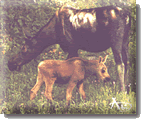 |
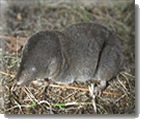 |
The Short-tailed Shrew is only 3-4 inches long, but it is the largest shrew in North America. Their eyes are almost invisible, and they have no ears. Shrews live in forests, grasslands, and marshes. They build nests out of shredded leaves, grass, and plant fibers. Shrews like to eat earthworms, snails, centipedes, and sometimes mice and smaller shrews. Their poisonous saliva kills their victims. |
| The White-tailed Jackrabbit, also known as the "Prairie Hare" or "White Hare", is pale grayish-brown in color, turning grayish-white in the winter. They have long, antenna-like ears and long legs which carry them at speeds up to 45 mph. White-tailed Jackrabbits make their home in the grasslands and farmlands of the Western states. They are strong swimmers and may plunge into a river or stream when pursued. |
 |
 |
Wood Rats are often called "pack rats" because they pick up bottle caps, paper, pieces of rope, and anything else they can find, and carry it to their nest. Their color is brownish-gray mixed with black on top, with lighter brown on the sides, throat, and belly. Wood Rats are nocturnal and feed on a wide variety of plants. They are found in rocky, timbered regions, and like to build their nests in crevices or small caves. |
| The Plains Pocket Gopher is a rodent and is related to the Ground Squirrel. It is cinnamon brown in color and has long front and back claws for digging its burrow which sometimes reaches 800 feet deep. The Plains Pocket Gopher gets its name from the pouches ("pockets") on its cheeks. It fills these pouches with food and then transports the food back to the burrow to store for later use. The Plains Pocket Gopher can be found in grasslands, alfalfa fields, pastures, and roadsides. |
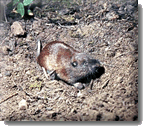 |
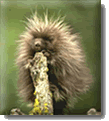 |
The Yellow-haired Porcupine's Latin name, Erethizon dorsatum, can be loosely translated as "the animal with the irritating back." And no wonder, because its back and upper body are estimated to have 30,000 quills! (There are none on the nose, legs, and underparts.) Porcupines move very slowly so their quills are their only protection from their faster moving enemies. The quills have several dozen small black barbs on them that cause a great deal of pain to attackers. The quills contain an antibiotic so they seldom cause infection in the attacker. |
| Audubon's Mountain Sheep, a subspecies of Bighorn Sheep, was first sighted by Lewis and Clark on April 26, 1805, in North Dakota. Bighorn sheep are distinguished by their large curved horns that keep growing during the life of the animal instead of being shed each year like the antlers of deer. They need extremely rugged terrain with steep canyon walls adjoining grassy meadows to survive. Some subspecies of Bighorn sheep are still found in the United States and Canada, however, because of uncontrolled hunting, the Audubon sheep became extinct around 1890. |
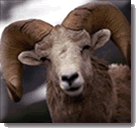 |
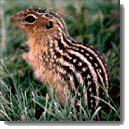 |
How many stripes does a Thirteen-lined Ground Squirrel have? Hmmm...13? That's right! This ground squirrel has 13 alternating dark and light stripes; the dark ones are dotted with white squarish, white spots. Thirteen-lined squirrels are small, 5 to 6 inches long and weighing from 4-10 ounces. They are found in much of central North America in pastures, lawns, and other short grassy areas. They are very active during the day and will stand straight up to look around. |
| Discovered by Lewis and Clark in 1805 at Great Falls, Montana, Lewis wrote "Their tallons appear longer than any species of fox I ever say and seem therefore prepared to more amply by nature for the purpose of burrowing." The Swift Fox is the smallest wild dog in North America. Its fur is light gray with orange-tan coloring on the sides and legs. They live in shortgrass prairies and deserts. Swift Foxes are not on the Endangered Species List, but at present there are only a few scattered populations in the Great Plains of the U.S. and in western Canada. |
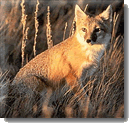 |
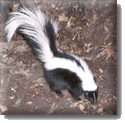 |
The Striped Skunk is about the size of the average-sized house cat. Its body is black with a white stripe running from its eyes to the tip of its tail (the stripe splits at the shoulders and forms a nice V along the skunk's back). Skunks are known for being very smelly creatures. When threatened, the skunk sprays a strong, musky smelling fluid at its would-be attacker. This fluid is very painful if sprayed in the eyes and can cause temporary loss of vision. When left alone, this nocturnal mammal likes to roam the desert, woodland, grassy plains, and suburb areas. |
| The Bushy-Tailed Woodrat is named for its squirrel-like, bushy tail. It is pale gray to brown to black in color with white underside. Like all woodrats, they are "pack rats," dropping whatever it is holding in favor of any shiny object. Bushy-tailed woodrats like to live in rocky areas and coniferous forests. |
 |
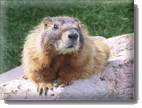 |
If the Yellow-bellied Marmot looks a lot like a groundhog, that's because he is, or at least, he is what people in the eastern United States call a groundhog. This heavy-bodied, grizzled buff-brown colored marmot is the animal that people watch to see if it sees its shadow on Groundhog Day. Marmots live about three years and eat a diet of native forbs, grasses, sedges, clovers, and alfalfa. |
| Ermine, or short-tailed weasels, are small, furry mammals, that can be found in the forests and tundra of the Northern United States and Europe. These weasels lose their brown summer fur when winter comes when they grow a pure white one. Only the black tip of their tail remains black during this transformation. Weasels are excellent hunters, catching and eating small mammals such as mice, squirrels, and rabbits. They also eat birds, eggs, fish and insects. |
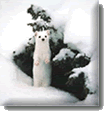 |
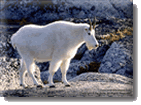 |
Mountain Goats spend their lifetime wandering the steep, snow-covered cliffs of North America's mountain ranges. Because they live in such remote areas, not much was known about the Mountain Goat until almost 1900. Mountain Goats have a thick, snow-white, poofy long coat of hair, that stops just below their knees. They have black horns that are 6-10 inches long. |
| Harbor Seals belong to the scientific order Pinnipedia, which includes walruses and sea lions. Unlike most pinnipeds, Harbor Seals are generally solitary and rarely interact with one another. They have short, thick fur, and long whiskers that aid their sense of touch. They feed on squids, crustaceans, mollusks, and fish. Harbor Seals can crush the shells of crustaceans and mollusks with their flat back teeth. |
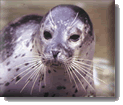 |
 |
The Columbian White-Tailed Deer is a medium-sized, brownish colored deer, with, you guessed it - white fur along and under its tail. These deer were plentiful in Lewis and Clark's time, but by the late 1800s, they were considered extinct. Pioneers had settled on much of the fertile farm land and either drove the deer away or hunted them. Columbian White-Tailed Deer were one of the original 78 species placed on the Federal Endangered Species List in 1967. Since that time, the White-Tailed Deer population has grown to over 6,000. |
| The Columbian Black-Tailed Deer has - right again- black markings on its tail (what were Lewis and Clark thinking!). This medium-sized deer has a stocky body with long, slim, sturdy legs. It is a subspecies of Mule Deer. Mule deer have large ears that can move independently like a mule's. They range the Pacific coast from British Columbia to northern California, along the forest edges, and in the mountains and foothills. |
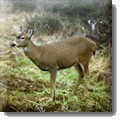 |
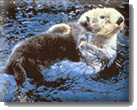 |
The Sea Otter has the thickest fur in the animal kingdom. Although it is beautiful fur, it has its disadvantages: the sea otter relies on its fur to keep warm (it does not have a layer of blubber like other mammals), so if the fur gets coated with oil or any other substance, the otter can easily die from cold and exposure; and, before it became a protected species, sea otters were hunted to near extinction by fur traders for their luxurious fur. The Sea Otter is the largest member of the weasel family. It can reach four feet in length and 100 pounds in weight. They inhabit the shallow coastal waters of the northern Pacific. |
| Roosevelt Elk, sometimes known as Olympic Elk or Wapiti (the Shoshone word for "pale" or "white"), are the second largest member of the deer family. This elk was part of the reason that Lewis and Clark expedition located their camp at Fort Clatsop during the winter of 1805/1806. Elk was their main source of food that winter as well as a source of clothing and footwear. In the summer they range in the open mountain pastures, and in the winter, in the lower wooded slopes and dense woods. |
 |
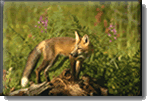 |
The Red Fox resembles a medium sized dog, has reddish-orange fur, and a thick bushy tail. Like most other members of the wild dog family, they are quite intelligent and very adaptable to their surroundings. Because of this, it is not unusual to find red foxes in urban areas. They eat a wide variety of food including mice, rabbits, earthworms, beetles, fruit, and small birds. Red foxes are nocturnal animals, rarely coming out during the day. |
| Lewis and Clark described the Oregon Bobcat at Fort Clatsop, Oregon in February 1806. They are a tawny color (more gray in the winter) with dark spotting, have short, stubby tails, and slightly tufted ears. They generally like to be left alone and avoid people, but sometimes they become curious about humans, pets, and activities. They may sit and observe from a vantage point, much like a common house cat does. |
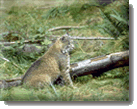 |
 |
Townsend's Chipmunk is a large, dark brown chipmunk, with black and pale stripes on its head and body, and a long, bushy tail. Chipmunks are shy but active creatures. They are good climbers and will run quickly up trees to flee enemies. They eat berries, acorns, maple seeds, conifer seeds, fungi, and insects. Townsend's Chipmunk is found from extreme southwestern British Columbia south through most of western Oregon. It was noted by Lewis and Clark at Fort Clatsop, Oregon. |
| Western Gray Squirrels is a tree squirrel that grows up to a length of 24 inches (including the long bushy tail!). They do not have cheek pouches like ground squirrels do. Their coat is gray above and white on the underside. The gray hairs of their coat and tail are tipped in white. The Gray Squirrel lives in woodland areas eating mostly acorns and does not hibernate in the winter like some ground squirrels do. |
 |
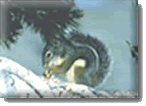 |
The Douglas Squirrel is olive brown in color with an orangish-buff belly and an orangish line of fur between the fur on its back and the fur on its belly. They are noisy squirrels and will often alert other forest creatures to danger by their loud scolding and chattering. Douglas Squirrels eat seeds from Douglas fir, Sitka Spruce, and Shore Pine pinecones. They get to the seed of the pinecones by stripping the cone's scales one by one. These squirrels also eat mushrooms. Of course, they dry them first by stashing them in the forks of tree branches! |
| Richardson's Ground Squirrel is a gray or yellowish gray squirrel which likes to live in the sandy, well-drained soils of prairies. There, it makes burrows 15-20 feet in length, 4-5 feet below the surface. Each burrow has a mound of dirt at the entrance where the squirrel often stands. It is nicknamed "flickertail" for the way it accompanies its shrill whistle with a flick of its tail. Because of its cheek pouches and the large amounts of seed it stores in them, Richardson's squirrel sometimes looks like it has a head that is much bigger than its body. |
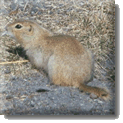 |
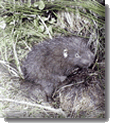 |
If you've never heard of a Mountain Beaver, you are not alone. Little is known about these rodents since they live underground, come out mostly at night, and never go very far from their burrows. They are dark brown except for a white spot below each ear; their fur is coarse and dull. Mountain Beavers like to live near water in forested areas at sea level to timberline peaks. They are herbivores and eat just about any type of vegetation. |
| The Western Badger was first noted by Lewis and Clark at Fort Clatsop, Oregon, in 1806. The badger got its name from the white, badgelike mark on its forehead. It can be from the western United States to eastern Texas, Oklahoma, northern Missouri, northern Illinois, northern Indiana and northern Ohio. The badger likes to live in open plains and prairies, farmland, and sometimes along the edges of woods. |
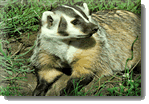 |
 |
You've probably never seen a mole in real life, but you've probably seen the damage they can do burrowing through someone's yard. Townsend's Mole is a large mole with black fur and a short, thick, nearly bare tail and snout. Its eyes are tiny but visible. It is about 7-8 inches in length and can be found in meadows, fields, and lawns along the Pacific coast from extreme southern British Columbia to northern California. |
| The Oregon Pronghorn Antelope can be found near the borders of Oregon, Idaho, California, and Nevada. DNA analysis has shown no different from the pronghorn antelope. Early settlers almost eliminated pronghorns from their native range in eastern Oregon. Hunting was finally prohibited in the early 1900s and was not allowed for 25 years thereafter. Herds are now established once again and limited hunting is allowed. Oregon Pronghorns like grasslands, grassy brushlands, and bunchgrass-sagegrass areas to live in. |
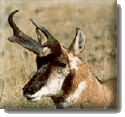 |
 |
The Columbian Ground Squirrel has white speckled brown, black, and gray fur on its head and back, and reddish-tan fur on its undersides. It can be found in open alpine meadows, dry grasslands, and brushy areas. This squirrel hibernates seven or eight months out of the year, starting as early as July. It has a special hibernation chamber in its burrow that is sealed off from the rest of the burrow with a plug of dirt. It stores seeds and bulbs in the chamber to eat when it wakes up in the spring. |
lewis & clark home || animals discovered || corps of discovery
jefferson's letter || the trail || links || glossary
education home || return to SWCD home
